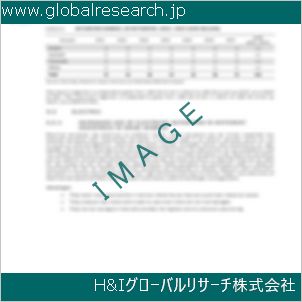Table of Contents
1 Industry Overview of Perlite
1.1 Definition and Specifications of Perlite
1.1.1 Definition of Perlite
1.1.2 Specifications of Perlite
1.2 Classification of Perlite
1.3 Applications of Perlite
1.3.1 Nuclear Application
1.3.2 Non-Nuclear Application
1.4 Industry Chain Structure of Perlite
1.5 Industry Overview and Major Regions Status of Perlite
1.5.1 Industry Overview of Perlite
1.5.2 Global Major Regions Status of Perlite
1.6 Industry Policy Analysis of Perlite
1.7 Industry News Analysis of Perlite
2 Manufacturing Cost Structure Analysis of Perlite
2.1 Raw Material Suppliers and Price Analysis of Perlite
2.2 Equipment Suppliers and Price Analysis of Perlite
2.3 Labor Cost Analysis of Perlite
2.4 Other Costs Analysis of Perlite
2.5 Manufacturing Cost Structure Analysis of Perlite
2.6 Manufacturing Process Analysis of Perlite
3 Technical Data and Manufacturing Plants Analysis of Perlite
3.1 Capacity and Commercial Production Date of Global Perlite Major Manufacturers in 2023
3.2 Manufacturing Plants Distribution of Global Perlite Major Manufacturers in 2023
3.3 R&D Status and Technology Source of Global Perlite Major Manufacturers in 2023
3.4 Raw Materials Sources Analysis of Global Perlite Major Manufacturers in 2023
4 Capacity, Production and Revenue Analysis of Perlite by Regions, Types and Manufacturers
4.1 Global Capacity, Production and Revenue of Perlite by Regions 2019-2024
4.2 Global and Major Regions Capacity, Production, Revenue and Growth Rate of Perlite 2019-2024
4.3 Global Capacity, Production and Revenue of Perlite by Types 2019-2024
4.4 Global Capacity, Production and Revenue of Perlite by Manufacturers 2019-2024
5 Price, Cost, Gross and Gross Margin Analysis of Perlite by Regions, Types and Manufacturers
5.1 Price, Cost, Gross and Gross Margin Analysis of Perlite by Regions 2019-2024
5.2 Price, Cost, Gross and Gross Margin Analysis of Perlite by Types 2019-2024
5.3 Price, Cost, Gross and Gross Margin Analysis of Perlite by Manufacturers 2019-2024
6 Consumption Volume, Consumption Value and Sale Price Analysis of Perlite by Regions, Types and Applications
6.1 Global Consumption Volume and Consumption Value of Perlite by Regions 2019-2024
6.2 Global and Major Regions Consumption Volume, Consumption Value and Growth Rate of Perlite 2019-2024
6.3 Global Consumption Volume and Consumption Value of Perlite by Types 2019-2024
6.4 Global Consumption Volume and Consumption Value of Perlite by Applications 2019-2024
6.5 Sale Price of Perlite by Regions 2019-2024
6.6 Sale Price of Perlite by Types 2019-2024
6.7 Sale Price of Perlite by Applications 2019-2024
6.8 Market Share Analysis of Perlite by Different Sale Price Levels
7 Supply, Import, Export and Consumption Analysis of Perlite
7.1 Supply, Consumption and Gap of Perlite 2019-2024
7.2 Global Capacity, Production, Price, Cost, Revenue, Supply, Import, Export and Consumption of Perlite 2019-2024
7.3 USA Capacity, Production, Price, Cost, Revenue, Supply, Import, Export and Consumption of Perlite 2019-2024
7.4 EU Capacity, Production, Price, Cost, Revenue, Supply, Import, Export and Consumption of Perlite 2019-2024
7.5 China Capacity, Production, Price, Cost, Revenue, Supply, Import, Export and Consumption of Perlite 2019-2024
7.6 Japan Capacity, Production, Price, Cost, Revenue, Supply, Import, Export and Consumption of Perlite 2019-2024
8 Major Manufacturers Analysis of Perlite
8.1 Manufacturer One
8.1.1 Company Profile
8.1.2 Product Picture and Specifications
8.1.2.1 Type I
8.1.2.2 Type II
8.1.2.3 Type III
8.1.3 Capacity, Production, Price, Cost, Gross and Revenue
8.1.4 Contact Information
8.2 Manufacturer Two
8.2.1 Company Profile
8.2.2 Product Picture and Specifications
8.2.2.1 Type I
8.2.2.2 Type II
8.2.2.3 Type III
8.2.3 Capacity, Production, Price, Cost, Gross and Revenue
8.2.4 Contact Information
8.3 Manufacturer Three
8.3.1 Company Profile
8.3.2 Product Picture and Specifications
8.3.2.1 Type I
8.3.2.2 Type II
8.3.2.3 Type III
8.3.3 Capacity, Production, Price, Cost, Gross and Revenue
8.3.4 Contact Information
8.4 Manufacturer Four
8.4.1 Company Profile
8.4.2 Product Picture and Specifications
8.4.2.1 Type I
8.4.2.2 Type II
8.4.2.3 Type III
8.4.3 Capacity, Production, Price, Cost, Gross and Revenue
8.4.4 Contact Information
8.5 Manufacturer Five
8.5.1 Company Profile
8.5.2 Product Picture and Specifications
8.5.2.1 Type I
8.5.2.2 Type II
8.5.2.3 Type III
8.5.3 Capacity, Production, Price, Cost, Gross and Revenue
8.5.4 Contact Information
…
9 Marketing Trader or Distributor Analysis of Perlite
9.1 Marketing Channels Status of Perlite
9.2 Traders or Distributors with Contact Information of Perlite by Regions
9.3 Ex-work Price, Channel Price and End Buyer Price Analysis of Perlite
9.4 Regional Import, Export and Trade Analysis of Perlite
10 Industry Chain Analysis of Perlite
10.1 Upstream Major Raw Materials Suppliers Analysis of Perlite
10.1.1 Major Raw Materials Suppliers with Contact Information Analysis of Perlite
10.1.2 Major Raw Materials Suppliers with Supply Volume Analysis of Perlite by Regions
10.2 Upstream Major Equipment Suppliers Analysis of Perlite
10.2.1 Major Equipment Suppliers with Contact Information Analysis of Perlite
10.2.2 Major Equipment Suppliers with Product Pictures Analysis of Perlite by Regions
10.3 Downstream Major Consumers Analysis of Perlite
10.3.1 Major Consumers with Contact Information Analysis of Perlite
10.3.2 Major Consumers with Consumption Volume Analysis of Perlite by Regions
10.4 Supply Chain Relationship Analysis of Perlite
11 Development Trend of Analysis of Perlite
11.1 Capacity, Production and Revenue Forecast of Perlite by Regions and Types
11.1.1 Global Capacity, Production and Revenue of Perlite by Regions 2024-2029
11.1.2 Global and Major Regions Capacity, Production, Revenue and Growth Rate of Perlite 2024-2029
11.1.3 Global Capacity, Production and Revenue of Perlite by Types 2024-2029
11.2 Consumption Volume and Consumption Value Forecast of Perlite by Regions, Types and Applications
11.2.1 Global Consumption Volume and Consumption Value of Perlite by Regions 2024-2029
11.2.2 Global and Major Regions Consumption Volume, Consumption Value and Growth Rate of Perlite 2024-2029
11.2.3 Global Consumption Volume and Consumption Value of Perlite by Types 2024-2029
11.2.4 Global Consumption Volume and Consumption Value of Perlite by Applications 2024-2029
11.3 Supply, Import, Export and Consumption Forecast of Perlite
11.3.1 Supply, Consumption and Gap of Perlite 2024-2029
11.3.2 Global Capacity, Production, Price, Cost, Revenue, Supply, Import, Export and Consumption of Perlite 2024-2029
11.3.3 USA Capacity, Production, Price, Cost, Revenue, Supply, Import, Export and Consumption of Perlite 2024-2029
11.3.4 EU Capacity, Production, Price, Cost, Revenue, Supply, Import, Export and Consumption of Perlite 2024-2029
11.3.5 China Capacity, Production, Price, Cost, Revenue, Supply, Import, Export and Consumption of Perlite 2024-2029
11.3.6 Japan Capacity, Production, Price, Cost, Revenue, Supply, Import, Export and Consumption of Perlite 2024-2029
12 New Project Investment Feasibility Analysis of Perlite
12.1 New Project SWOT Analysis of Perlite
12.2 New Project Investment Feasibility Analysis of Perlite
13 Conclusion of the Global Perlite (CAS 93763-70-3) Industry 2024 Market Research Report
| ※参考情報 真珠岩(Perlite)は、主に火山岩から成る軽量の鉱鉱であり、その特有の性質から広く利用されています。真珠岩は、主にシリカ(SiO₂)を主体とした自然の鉱石であり、加熱処理を施すことでその特性が飛躍的に向上します。加熱すると内部の水分が蒸発し、体積が数倍に膨張し、軽量かつ多孔質の素材となります。このプロセスによって、新たな特性が付加され、さまざまな用途に利用されることとなります。 真珠岩の特徴として、まず軽量性が挙げられます。膨張した真珠岩は、従来の鉱石に比べて圧倒的に軽く、輸送や取り扱いが容易です。また、非常に多孔質な構造を持つため、通気性や保水性に優れ、多くの農業や園芸分野においても重宝されています。さらに、真珠岩は化学的に非常に安定しており、酸やアルカリに対して耐性があります。そのため、さまざまな環境条件下での使用が可能です。加えて、不燃性の特性もあり、火災に対する安全性が高いという利点があります。 真珠岩には主に二つの種類が存在します。一つは膨張真珠岩で、もう一つは未膨張真珠岩です。膨張真珠岩は、加熱処理を経たもので、軽量かつ多孔質な構造を持つため、主に建設資材や農業で用いられています。未膨張真珠岩は、天然の状態で利用されることが多く、特に鉱業や鉱石のフィルターとしての用途があります。 真珠岩の用途は多岐にわたります。まず、農業や園芸においては、土壌改良材として使用されることが一般的です。真珠岩の軽量性と保水性により、植栽時の根の発育を助け、作物の健全な成長を促します。また、通気性が良いため、過湿による根腐れを防ぐ効果もあります。さらに、ボロやトルコの建材での利用が進んでおり、断熱材や軽量骨材、内装仕上げ材として用いられています。真珠岩は、リフォームや新築の時に、コンクリートやモルタルと混ぜて使用することで、より軽量かつ断熱性の高い構造を作成可能です。 また、真珠岩は耐火性にも優れていますので、工業製品や建築物の防火材料としても使用されます。特に、冶金分野においては、鋳造用砂としての利用があり、高温環境でもその特性を保持するため、安定性が求められる場面での利用が見込まれています。さらに、他の分野においても、スポーツ用品やパッケージング材、フィルターの素材としての需要が増えてきています。 技術的な観点から見ると、真珠岩の膨張には特定の加熱条件が必要です。一般には、約800℃以上の高温で加熱された際に、内部の水分が瞬時に蒸発し、発泡することで膨張する現象が見られます。このため、真珠岩を膨張させるための炉や設備の設計も重要な要素となります。また、真珠岩の表面処理技術も進化しており、さまざまな製品に応じた仕様にカスタマイズできるようになっています。 環境への配慮も重要なポイントです。真珠岩は自然素材であり、持続可能な資源として位置づけられています。掘削・加工の過程においても、環境負荷を最小限に抑える技術や方法が模索されています。真珠岩の再利用やリサイクル技術が発展することで、環境に優しい素材としての地位をさらに強固なものにすることが期待されています。 総じて、真珠岩はその優れた物理的・化学的特性により、多様な分野で応用される素材であります。軽量性、多孔質性、耐火性、化学的安定性などの特徴を活かし、施工・農業・工業など幅広い用途において役立っています。技術の進化に伴い、その利便性は今後もますます広がっていくことでしょう。真珠岩がもたらす可能性は、今後のさまざまな課題に対する解決策となり、持続可能な開発にも寄与するものと期待されています。 |
❖ 免責事項 ❖
http://www.globalresearch.jp/disclaimer












